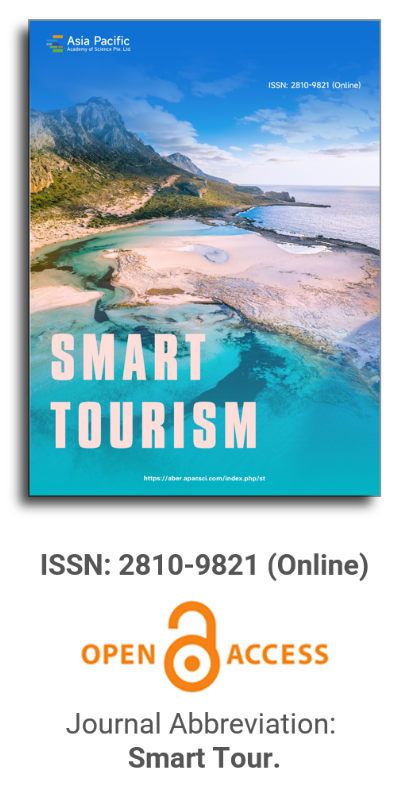


Methodology to analyse cybersecurity in tourism
Vol 5, Issue 1, 2024
Download PDF
Abstract
Nowadays hyperconnectivity provides an opportunity for tourism industry to benefit from big data analytics as determining competitive factor, for decision making, product design and assertive marketing strategies for target segments; but at the same time, having financial, organizational and personal information stored in cyberspace and available to many users makes vulnerable to security risks like phishing and hacking, both common cybercrimes that affect tourism sector. This paper, introduces representation and model design stages of our own methodology based on self-organization approach that we propose to reinforce cybersecurity in tourism, as part of a research project founded by National Council for Science and Technology postdoctoral scholarship for Mexico.
Keywords
References
- UNWTO. Tourism highlights, 2019th edtion. World Tourism Organization; 2019.
- First work report of the ministry of tourism 2018-2019. Available online: https://www.gob.mx/sectur/articulos/primer-informe-de-labores-de-la-secretaria-de-turismo-2018-2019-218765?idiom=es (accessed on 9 January 2024).
- Alcántara-Pilar JM, del Barrio-García S, Crespo-Almendros E, et al. Toward an understanding of online information processing in e-tourism: does national culture matter? Journal of Travel & Tourism Marketing. 2017; 1-15. doi: 10.1080/10548408.2017.1326363
- Heylighen F. Collective intelligence and its implementation on the web. Computational and Mathematical Theory of Organizations. 1999, 5(3): 253–280. doi: 10.1023/A:1009690407292
- Hutchins E. Cognition in the Wild. MIT Press. 1995.
- Gershenson C. Design and control of self-organizing systems. Copit Arxives. 2007.
- Fragniere E, Yagci K. Chapter: Network & Cyber Security in Hospitality and Tourism. Hospitality & Tourism Information Technology. University of South Florida M3 Publishing. 2021.
- Djebbar F, Nordström K. A Comparative Analysis of Industrial Cybersecurity Standards. IEEE Access. 2023; 11: 85315-85332. doi: 10.1109/access.2023.3303205
- Che Mat NI, Jamil N, Yusoff Y, et al. A systematic literature review on advanced persistent threat behaviors and its detection strategy. Journal of Cybersecurity. 2024; 10(1). doi: 10.1093/cybsec/tyad023
- Abelson H, Anderson R, Bellovin SM, et al. Bugs in our pockets: the risks of client-side scanning. Journal of Cybersecurity. 2024; 10(1). doi: 10.1093/cybsec/tyad020
- Ardito L, Cerchione R, Del Vecchio P, et al. Big data in smart tourism: challenges, issues and opportunities. Current Issues in Tourism. 2019; 22(15): 1805-1809. doi: 10.1080/13683500.2019.1612860
- Naqvi B, Perova K, Farooq A, et al. Mitigation strategies against the phishing attacks: A systematic literature review. Computers & Security. 2023; 132: 103387. doi: 10.1016/j.cose.2023.103387
- Paraskevas A. Cybersecurity in Travel and Tourism: A Risk-based Approach. In: Handbook of e-Tourism. Xiang Z, Fuchs M, Gretzel U, et al. (editors). Cham: Springer Nature Switzerland AG; 2020. doi: https://doi.org/10.1007/978-3-030-05324-6
- Xiang Z, Fuchs M, Gretzel U, et al. Handbook of E-Tourism. Springer International Publishing; 2020. doi: 10.1007/978-3-030-05324-6
- Ashby WR. The nervous system as physical machine: With special reference to the origin of adaptive behavior. Mind. 1947; 56(221): 44–59. doi: 10.1093/mind/lvi.221.44
- Florido-Benítez L. The Cybersecurity Applied by Online Travel Agencies and Hotels to Protect Users’ Private Data in Smart Cities. Smart Cities. 2024; 7(1): 475-495. doi: 10.3390/smartcities7010019
- Beer S. Decision and control: The meaning of operational research and management cybernetics. John Wiley and Sons. 1966.
- Wiener N. Cybernetics or Control and Communication in the Animal and the Machine. Wiley and Sons. 1948.
- Ashby WR. An Introduction to Cybernetics. Chapman & Hall. 1956.
- Bonabeau E, Dorigo M, Theraulaz G. Swarm intelligence: From natural to artificial systems. Santa Fe Institute studies in the sciences of complexity. Oxford University Press. 1999.
- Di Marzo Serugendo G, Karageorgos A, Rana OF, Zambonelli F. Engineering self-organising systems, nature-inspired approaches to software engineering. Lecture Notes in Computer Science. Springer; 2004.
- Zambonelli F, Rana OF. Self-Organization in Distributed Systems Engineering: Introduction to the Special Issue. IEEE Transactions on Systems, Man, and Cybernetics—Part A: Systems and Humans. 2005; 35(3): 313-315. doi: 10.1109/tsmca.2006.846372
- Wooldridge M, Jennings NR, Kinny D. The Gaia methodology for agent-oriented analysis and design. Journal of Autonomous Agents and Multi-Agent Systems. 2000; 3(3): 285–312. doi: 10.1023/A:1010071910869
- Zambonelli F, Jennings NR, Wooldridge M. Developing multiagent systems. ACM Transactions on Software Engineering and Methodology. 2003; 12(3): 317-370. doi: 10.1145/958961.958963
- Jones PM, Contractor N, O’Keefe B, Lu SC. Competence models and self-organizing systems: Towards intelligent, evolvable, collaborative support. In: 1994 IEEE International Conference. pp. 367–372.
- Gershenson C, Heylighen F. When can we call a system selforganizing? In: Advances in Artificial Life, 7th European Conference, ECAL 2003 LNAI 2801. Springer; 2003. pp. 606–614.
- Ashby WR. Principles of the self-organizing system. Principles of self-organization. In: Foerster HV, Zopf, Jr., GW (editors). Pergamon, Oxford; 1962. pp. 255–278.
- François C. International Encyclopedia of Systems and Cybernetics. Published online December 31, 2004. doi: 10.1515/9783110968019
- Kauffman SA. Investigations. Oxford University Press; 2000.
- Holland JH. Adaptation in natural and artificial systems. The University of Michigan Press; 1975.
- Shalizi CR. Causal architecture, complexity and self-organization in time series and cellular automata [PhD thesis]. University of Wisconsin at Madison. 2001.
- Luo S, Choi TM. E-commerce supply chains with considerations of cyber-security: Should governments play a role? Prod. Oper. Manag. 2022; 31, 2107–2126. doi: 10.1111/poms.13666
- Fraud in the tourism sector (Spanish). 33 Mesa de seguridad turística SSPC. Mexico. 2022.
- UN DESA. The Sustainable Development Goals Report 2023: Special Edition. UN DESA; 2023.
- Boustead AE, Kugler MB. Juror interpretations of metadata and content information: Implications for the going dark debate. Journal of Cybersecurity. 2023; 9(1). doi: 10.1093/cybsec/tyad002
Supporting Agencies
Consejo Nacional de Humanidades Ciencias y Tecnologías CONAHCYT Mexico
Copyright (c) 2024 Tanya Arenas, Julián Patiño, Miguel Ángel Martínez, Humberto Dorantes, Mauricio Chávez
License URL: https://creativecommons.org/licenses/by/4.0/

This site is licensed under a Creative Commons Attribution 4.0 International License (CC BY 4.0).

Prof. Hung-Che Wu
Nanfang College, Guangzhou
China
Indexing & Archiving
Asia Pacific Academy of Science Pte. Ltd. (APACSCI) specializes in international journal publishing. APACSCI adopts the open access publishing model and provides an important communication bridge for academic groups whose interest fields include engineering, technology, medicine, computer, mathematics, agriculture and forestry, and environment.



.jpg)
.jpg)

.jpg)

